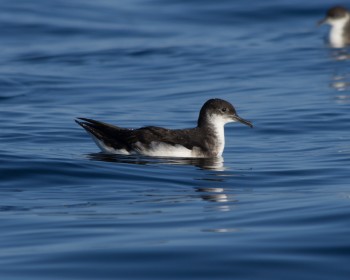 Manx Shearwater at sea, photograph by Nathan Fletcher
Manx Shearwater at sea, photograph by Nathan Fletcher
Natasha Gillies (Department of Zoology, University of Oxford, UK) and colleagues have published in the Journal of Avian Biology on how Manx Shearwaters Puffinus puffinus partners coordinate their nest visits during chick feeding.
The paper’s abstract follows:
“Many species that provide care for their offspring in tandem with a partner coordinate their activities to maximise the efficiency of their investment. However, it is not well known exactly how this coordination is achieved. Manx shearwaters Puffinus puffinus are Procellariiform seabirds that exhibit a dual foraging strategy during chick provisioning in which long foraging trips to maintain condition are alternated with short, frequent trips to feed the offspring. This strategy is employed in a coordinated manner between the parents, with one making short trips while the other takes a single long trip. Previous work revealed that a complementary switch in foraging trip type is initiated by the parents following a synchronous visit to the nest. We used a combination of observational data and experimental manipulation to examine the mechanisms that may underlie this behaviour. Specifically, we investigated the evidence that physical reunion is necessary to induce a switch in trip type, whether parents change their behaviour to maximise the probability of partner encounter, and whether indirect cues gained from the chick could inform a switch in behaviour. In our experimental approach, we manipulated the information adults had available to them by supplementarily feeding chicks to alter their begging behaviour. We found no support for the role of physical reunion or indirect cues in the coordination of care in this species. We discuss the possibility that the patterns of alternated provisioning observed during chick rearing in Manx shearwaters may emerge through entrainment during the well-coordinated incubation period preceding chick provisioning.”
Reference:
Gillies, N., Tyson, C., Wynn, J., Syposz, M., Vansteenberghe, C. & Guilford, T. 2021. Exploring the mechanisms of coordinated chick provisioning in the Manx shearwater Puffinus puffinus. Journal of Avian Biology doi.org/10.1111/jav.02881.
John Cooper, ACAP Information Officer, 16 November 2021

 English
English  Français
Français  Español
Español